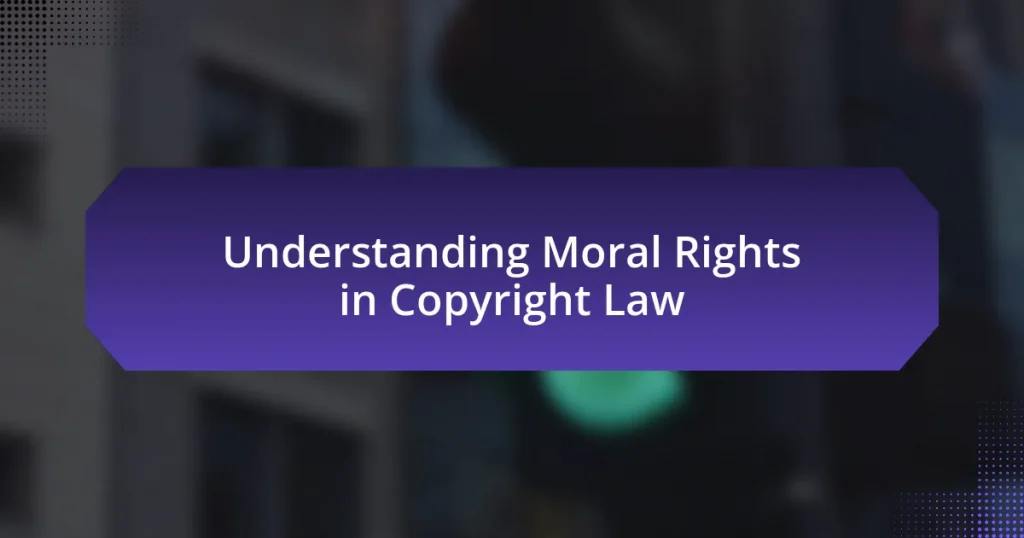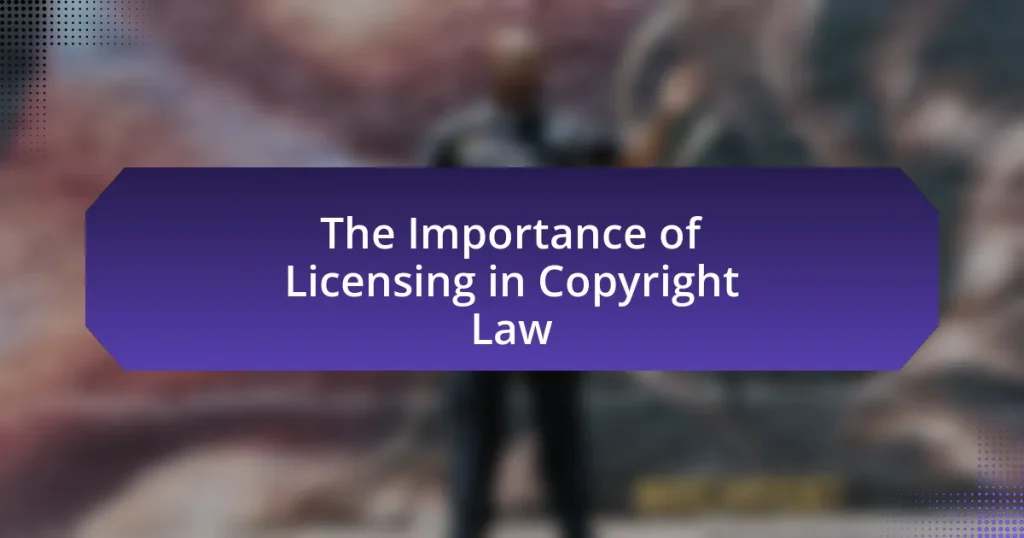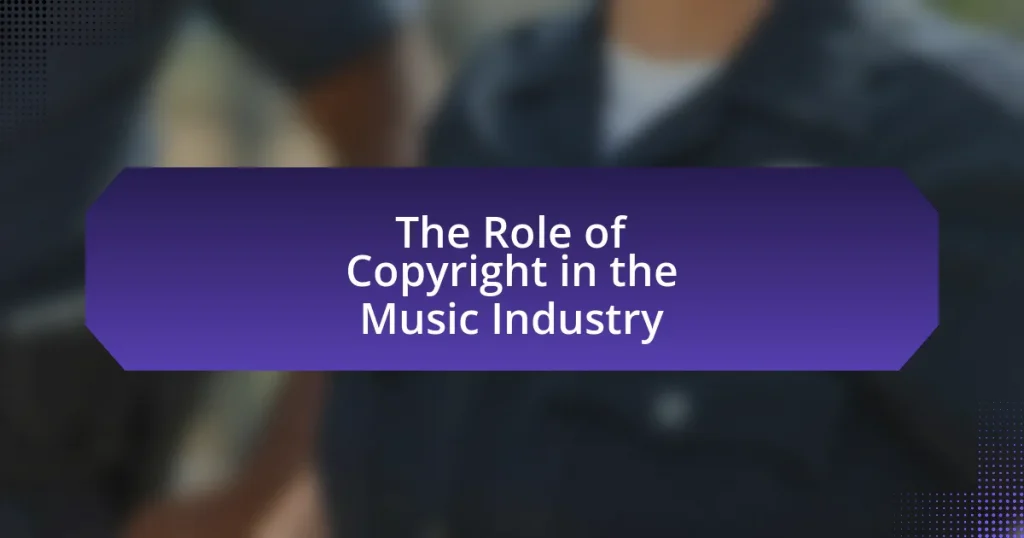Copyright law plays a crucial role in the realm of digital art by providing legal protection for creators, allowing them to control the use and distribution of their work. The article explores how copyright law defines digital art, differentiates it from traditional art, and outlines the rights and protections afforded to digital artists under the U.S. Copyright Act. It also addresses the challenges artists face in enforcing their rights in a digital environment, the impact of emerging technologies like blockchain and AI on copyright, and the importance of international treaties in safeguarding artists’ rights globally. Additionally, best practices for protecting digital art and resources for understanding copyright law are discussed, highlighting the evolving landscape of copyright in the digital age.

What is the Impact of Copyright Law on Digital Art?
Copyright law significantly impacts digital art by providing legal protection for creators, ensuring their rights to control the use and distribution of their work. This legal framework allows artists to prevent unauthorized reproduction and distribution, which is crucial in a digital environment where copying is easy. For instance, the U.S. Copyright Act of 1976 grants creators exclusive rights to their original works, including digital art, thereby enabling them to monetize their creations and protect their intellectual property. Additionally, copyright law fosters innovation by encouraging artists to create new works, knowing they have legal recourse against infringement.
How does copyright law define digital art?
Copyright law defines digital art as original works of authorship that are created and fixed in a digital medium. This includes various forms such as digital paintings, illustrations, animations, and photographs that are expressed in a digital format. Under the U.S. Copyright Act, digital art is protected as long as it meets the criteria of originality and fixation, meaning the work must be independently created by the artist and captured in a tangible medium, such as a computer file. This legal framework ensures that creators have exclusive rights to reproduce, distribute, and display their digital artworks, thereby safeguarding their intellectual property against unauthorized use.
What are the legal definitions of digital art under copyright law?
Digital art is legally defined under copyright law as original works of authorship that are created using digital technology. This includes any artistic creation that is fixed in a tangible medium, such as digital paintings, illustrations, animations, and 3D models. Copyright law protects these works from unauthorized reproduction, distribution, and public display, provided they meet the criteria of originality and fixation as outlined in the U.S. Copyright Act of 1976. The act specifies that copyright protection is granted to “original works of authorship,” which encompasses digital art as long as it is independently created and exhibits a minimal degree of creativity.
How does copyright law differentiate between traditional and digital art?
Copyright law differentiates between traditional and digital art primarily through the medium of expression and the methods of reproduction. Traditional art, such as paintings or sculptures, is often protected under copyright as a physical object, while digital art is protected as a digital file or software. This distinction affects how rights are enforced and how infringement is assessed. For instance, traditional art may involve issues related to physical reproduction, whereas digital art often raises concerns about unauthorized copying and distribution over the internet. The U.S. Copyright Office recognizes both forms as copyrightable, but the application of rights can vary based on the medium, as digital art may also involve additional layers of copyright related to software and technology used in its creation.
Why is copyright law important for digital artists?
Copyright law is important for digital artists because it protects their original works from unauthorized use and reproduction. This legal framework ensures that artists retain ownership of their creations, allowing them to control how their art is used and to receive compensation for its use. According to the U.S. Copyright Office, copyright protection automatically applies to original works of authorship fixed in a tangible medium, which includes digital art. This legal recognition empowers artists to enforce their rights, seek damages for infringement, and promote their work without fear of exploitation.
What rights do digital artists have under copyright law?
Digital artists have the exclusive rights to reproduce, distribute, and display their original works under copyright law. This legal framework grants them ownership of their creations, allowing them to control how their art is used and shared. According to the U.S. Copyright Office, copyright protection automatically applies to original works of authorship fixed in a tangible medium, which includes digital art. This means that digital artists can prevent unauthorized use of their work, seek licensing agreements, and pursue legal action against infringement.
How does copyright law protect the interests of digital artists?
Copyright law protects the interests of digital artists by granting them exclusive rights to their original works, which includes the right to reproduce, distribute, and display their creations. This legal framework ensures that digital artists can control how their art is used and monetized, preventing unauthorized use or reproduction by others. For instance, under the U.S. Copyright Act, digital artists automatically receive copyright protection upon the creation of their work, which allows them to take legal action against infringement. This protection is crucial in the digital age, where art can be easily copied and shared online, thus safeguarding the financial and moral rights of artists.
What challenges do digital artists face regarding copyright law?
Digital artists face significant challenges regarding copyright law, primarily due to the complexities of protecting their work in a digital environment. The ease of copying and distributing digital art online makes it difficult for artists to enforce their rights and prevent unauthorized use. Additionally, the ambiguity surrounding the ownership of derivative works complicates matters, as artists often struggle to determine how much of their original work can be altered by others without infringing on their copyright. Furthermore, the rapid evolution of technology outpaces existing copyright laws, leaving artists vulnerable to exploitation and diminishing their ability to claim rightful ownership. These challenges highlight the need for clearer legal frameworks that address the unique aspects of digital art and its distribution.
What are common copyright infringement issues in digital art?
Common copyright infringement issues in digital art include unauthorized reproduction, distribution, and modification of artworks. Digital artists often face challenges when their work is copied and shared online without permission, leading to loss of revenue and recognition. Additionally, the use of copyrighted images or elements in new creations without proper licensing can result in legal disputes. According to a study by the Visual Artists Rights Act, artists have reported that over 70% of their work has been used without consent, highlighting the prevalence of these issues in the digital landscape.
How do digital artists navigate copyright disputes?
Digital artists navigate copyright disputes by understanding their rights and utilizing legal frameworks to protect their work. They often register their artwork with copyright offices to establish ownership, which provides legal evidence in disputes. Additionally, artists may seek legal advice to interpret copyright laws and assess the validity of their claims or defenses. Many digital artists also use licensing agreements to clarify usage rights and prevent unauthorized use of their work. Furthermore, they can leverage online platforms that offer dispute resolution services, which can facilitate negotiations and settlements without resorting to litigation.
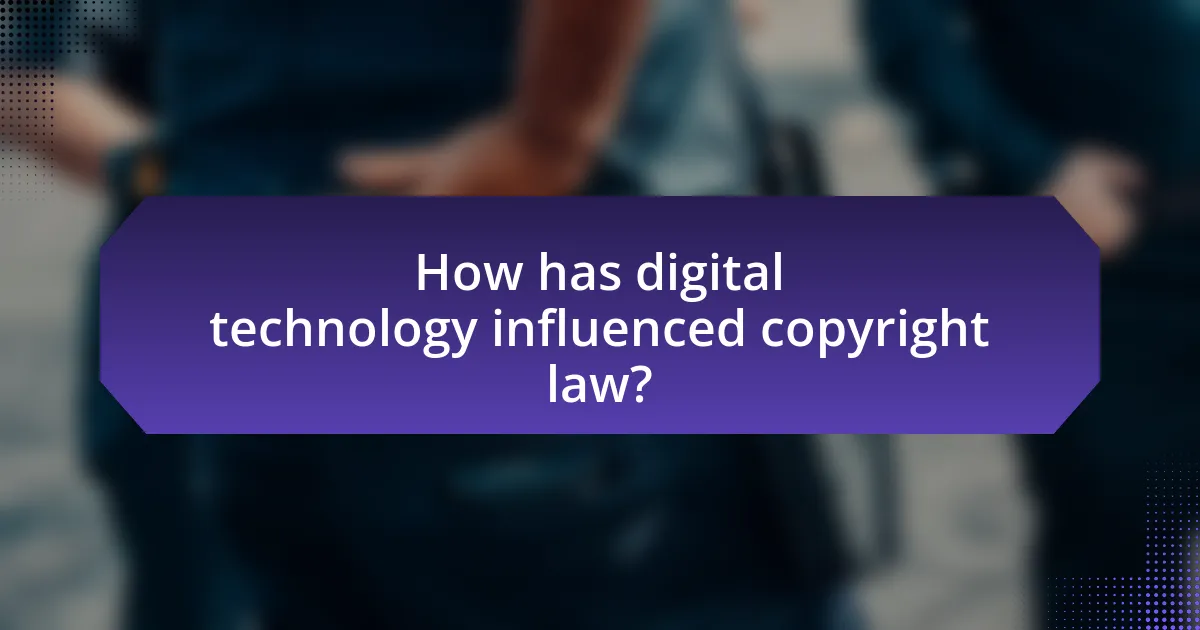
How has digital technology influenced copyright law?
Digital technology has significantly influenced copyright law by necessitating updates to address issues related to digital reproduction and distribution. The rise of the internet and digital media has led to increased instances of copyright infringement, prompting lawmakers to adapt existing laws to protect creators’ rights in the digital space. For example, the Digital Millennium Copyright Act (DMCA) of 1998 was enacted to address the challenges posed by digital technology, including the unauthorized sharing of copyrighted materials online. This law established a framework for copyright protection in the digital environment, including provisions for safe harbor for online service providers and penalties for copyright infringement. As a result, digital technology has driven the evolution of copyright law to better safeguard intellectual property in an increasingly digital world.
What changes have occurred in copyright law due to digital advancements?
Copyright law has undergone significant changes due to digital advancements, primarily through the introduction of the Digital Millennium Copyright Act (DMCA) in 1998, which aimed to address the challenges posed by the internet and digital media. The DMCA established provisions for the protection of copyrighted works in the digital environment, including anti-circumvention measures that prevent the unauthorized access and distribution of digital content. Additionally, the rise of online platforms has led to the implementation of safe harbor provisions, which protect service providers from liability for user-generated content, provided they comply with takedown requests. These changes reflect the need to balance the rights of creators with the realities of digital distribution, as evidenced by the increasing number of copyright infringement cases related to digital art and the evolving interpretations of fair use in the context of online sharing.
How has the rise of the internet affected copyright enforcement?
The rise of the internet has significantly complicated copyright enforcement by increasing the ease of content sharing and distribution. Digital platforms enable rapid dissemination of copyrighted material, making it challenging for copyright holders to monitor and protect their works effectively. For instance, a study by the International Intellectual Property Alliance reported that online piracy costs the U.S. economy billions annually, highlighting the difficulties in enforcing copyright laws in a digital landscape. Additionally, the proliferation of user-generated content platforms has blurred the lines of ownership, leading to disputes over fair use and licensing.
What role do digital platforms play in copyright issues for artists?
Digital platforms serve as both facilitators and challengers of copyright issues for artists. They enable artists to distribute their work widely and reach global audiences, which can enhance visibility and potential revenue. However, these platforms also often host user-generated content that may infringe on copyright, leading to disputes over ownership and rights. For instance, platforms like YouTube and Instagram have faced legal challenges regarding the unauthorized use of copyrighted material, prompting them to implement content identification systems to manage copyright claims. This dual role highlights the complexity of copyright enforcement in the digital age, where the ease of sharing content can conflict with the protection of artists’ intellectual property rights.
How do international copyright laws impact digital art?
International copyright laws significantly impact digital art by providing legal protection for creators against unauthorized use and reproduction of their work. These laws, such as the Berne Convention and the Agreement on Trade-Related Aspects of Intellectual Property Rights (TRIPS), establish minimum standards for copyright protection across member countries, ensuring that digital artists retain rights to their creations globally. For instance, under the Berne Convention, artists automatically receive copyright protection without the need for registration, which is crucial in the digital realm where art can be easily copied and distributed. This legal framework helps to safeguard the economic interests of digital artists, allowing them to monetize their work and control its distribution, thereby fostering creativity and innovation in the digital art community.
What are the differences in copyright laws across countries?
Copyright laws vary significantly across countries, primarily in terms of duration, scope, and enforcement mechanisms. For instance, in the United States, copyright protection lasts for the life of the author plus 70 years, while in many European countries, such as France, it also lasts for the life of the author plus 70 years but includes moral rights that protect the personal and reputational interests of the creator. Additionally, some countries, like India, have specific provisions for fair use that differ from the more restrictive interpretations in others, such as Japan. Enforcement practices also differ; in countries with strong legal frameworks, such as Germany, copyright infringement is pursued vigorously, whereas in others, like Nigeria, enforcement may be lax, leading to widespread piracy. These differences can significantly impact how digital art is created, shared, and monetized globally.
How do international treaties affect digital artists’ rights?
International treaties significantly influence digital artists’ rights by establishing standardized protections for their creative works across borders. Treaties such as the Berne Convention and the Agreement on Trade-Related Aspects of Intellectual Property Rights (TRIPS) provide a framework that ensures digital artists receive recognition and protection for their copyrights internationally. For instance, the Berne Convention mandates that member countries recognize the copyright of works created by artists from other member states, which helps prevent unauthorized use of digital art. Additionally, TRIPS sets minimum standards for copyright protection, including the duration of rights and enforcement measures, thereby enhancing the legal recourse available to digital artists globally. These treaties collectively foster an environment where digital artists can safeguard their rights and pursue legal action against infringement, thereby promoting creativity and innovation in the digital art sector.
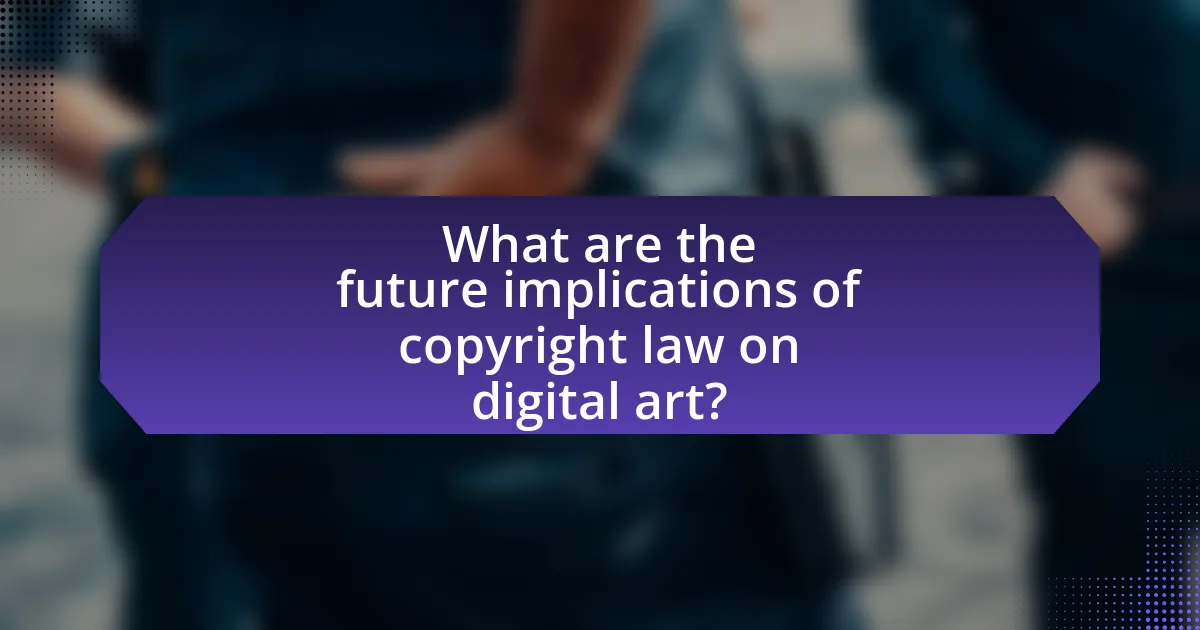
What are the future implications of copyright law on digital art?
The future implications of copyright law on digital art include increased protection for artists and potential challenges regarding ownership and distribution. As digital art becomes more prevalent, copyright law is likely to evolve to address issues such as unauthorized reproduction and the use of artificial intelligence in creating art. For instance, the U.S. Copyright Office has already begun to recognize the need for updated guidelines that reflect the unique characteristics of digital works, which may lead to more robust legal frameworks. Additionally, the rise of blockchain technology could facilitate new methods of verifying ownership and provenance, further impacting how digital art is bought and sold.
How might emerging technologies reshape copyright law for digital art?
Emerging technologies, such as blockchain and artificial intelligence, are likely to significantly reshape copyright law for digital art by enhancing ownership verification and altering the creation process. Blockchain technology can provide immutable records of ownership and provenance, making it easier to establish and enforce copyright claims. For instance, NFTs (non-fungible tokens) utilize blockchain to authenticate digital artworks, allowing artists to retain control over their work and receive royalties on secondary sales. Additionally, AI-generated art raises questions about authorship and copyright, as traditional laws may not adequately address the rights of both the creator and the technology used. This evolving landscape necessitates updates to copyright law to accommodate new forms of creation and distribution, ensuring that artists are protected while fostering innovation in the digital art space.
What potential legal challenges could arise with AI-generated art?
AI-generated art may face several legal challenges, primarily related to copyright issues. One significant challenge is the question of authorship; since AI lacks legal personhood, determining who holds the copyright—whether the creator of the AI, the user who prompted the AI, or the AI itself—remains unresolved. Additionally, if AI-generated art incorporates elements from existing copyrighted works, it could lead to infringement claims, as seen in cases where AI models are trained on copyrighted datasets without permission. Furthermore, the lack of clear legal frameworks governing AI-generated content complicates enforcement and protection of rights, creating uncertainty for artists and developers alike.
How could blockchain technology influence copyright protection?
Blockchain technology could significantly enhance copyright protection by providing a decentralized and immutable ledger for tracking ownership and usage rights of digital art. This technology allows artists to register their works on the blockchain, creating a permanent record that verifies their authorship and the terms of use. For instance, platforms like Ethereum enable the creation of non-fungible tokens (NFTs), which serve as unique digital certificates of ownership for artworks. This ensures that artists can maintain control over their creations and receive royalties automatically through smart contracts whenever their work is resold. The transparency and security of blockchain also reduce the risk of copyright infringement, as all transactions and ownership changes are publicly accessible and verifiable.
What best practices should digital artists follow regarding copyright?
Digital artists should register their works with the U.S. Copyright Office to establish legal ownership and protect their rights. This registration provides a public record of the work and is essential for enforcing copyright in case of infringement. Additionally, artists should include copyright notices on their works, which serve as a deterrent against unauthorized use and inform others of their rights. Furthermore, understanding the fair use doctrine is crucial, as it outlines the circumstances under which copyrighted material can be used without permission. Artists should also keep detailed records of their creative process and any licenses granted for their work, as this documentation can be vital in disputes. Lastly, staying informed about copyright laws and changes is essential for maintaining compliance and protecting their creations effectively.
How can digital artists effectively protect their work?
Digital artists can effectively protect their work by utilizing copyright registration, watermarking, and licensing agreements. Copyright registration provides legal recognition of ownership, allowing artists to enforce their rights against unauthorized use. Watermarking serves as a deterrent against theft by visibly marking the artwork with the artist’s information, making it clear who the creator is. Licensing agreements enable artists to specify how their work can be used, ensuring they retain control over its distribution and reproduction. According to the U.S. Copyright Office, registering a work can significantly enhance an artist’s ability to pursue legal action in cases of infringement, reinforcing the importance of these protective measures.
What resources are available for understanding copyright law in digital art?
Resources available for understanding copyright law in digital art include the U.S. Copyright Office website, which provides comprehensive information on copyright registration and protections. Additionally, the Creative Commons organization offers licenses that help artists understand how to share their work legally while retaining rights. Legal textbooks such as “Copyright Law in a Nutshell” by Arthur R. Miller provide detailed explanations of copyright principles. Online courses from platforms like Coursera and edX also cover copyright law in the context of digital art, offering structured learning. Furthermore, academic journals such as the “Journal of Intellectual Property Law & Practice” publish articles that analyze current issues in copyright law relevant to digital art.

